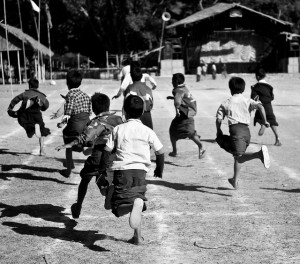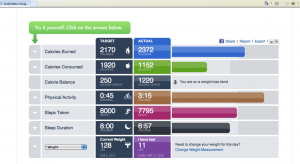
Obesity among children is on the rise, but just telling them to out and get more exercise doesn’t work well. Tracy Curran hopes technology and counseling can help. (Photo: Wagner T. Cassimiro "Aranha"/Flickr)
[Ed. Note: This is the second in a series about Children’s Hospital Boston staff who received Patient Services Research Grants in 2011. This grant program engages the professional staff in the Department of Patient Services in high quality pediatric research with the ultimate goal of improving child health]
We all look at babies and fall in love with their chubby little legs and paunchy bellies. (When my younger son was a baby, a friend often jokingly threatened to “eat him like a marshmallow.”)
Cute as it is in babies, though, children can’t afford to have that cushioning as they get older. Obesity threatens the future health of a whole generation of children, putting them at risk for a host of long-term health problems like high blood pressure, type 2 diabetes (increasingly starting in childhood) and cardiovascular disease. This is on top of more immediate problems like sleep apnea, asthma, low self-esteem, depression, fatty liver disease (which can turn into cirrhosis) and joint pain.
“Obesity just keeps going up in children and adolescents, and has become a major threat to health,” according to Tracy Curran, an exercise physiologist who works with the Children’s Preventive Cardiology Clinic (PCC). To her, the effect is clear: She is now seeing more and more children with the kinds of acquired heart disease usually found in adults.
A lack of exercise is a big contributor to the problem. “Our kids have become a lot more sedentary,” says Curran. “Most of the patients I see in the PCC aren’t getting the recommended 60 minutes of moderate to vigorous exercise every day.”
Simply discussing exercise with patients and sending them on their way, which is the current standard practice, doesn’t always work. With the support of a Patient Services Research Grant, Curran wants to find out whether a more interactive program would be more beneficial.
Here’s how: Curran will recruit from among teens and young adults referred to the PCC. Half of the patients who sign onto her study will, at random, receive the standard care provided by their cardiologist. The other half will receive exercise counseling using the FITT Principle (encouraging a specific frequency, intensity, time and type of exercise), and use an online tool and a device called BodyMedia (which records physical activity using an accelerometer and other sensors) to track their exercise, including the amount of time they’ve spent exercising and the calories they’ve burned.
The participants in the FITT group will also have weekly contact with an exercise physiologist by phone or email, which will give the teens a chance to review their progress and the physiologist an opportunity to provide encouragement and feedback.

A screenshot from BodyMedia's online tool, which the teens in the FITT arm of Curran's study will use to track their exercise.
After 12 weeks, Curran and her team will compare the amount of energy expended by the teens in each group and their level of activity. They will also look for changes in measures of fitness level, like VO2 max, and physical measurements related to heart disease risk such as blood pressure, body mass index (BMI), and lipid profiles.
The study is just getting off the ground, and Curran hopes that the combination of technology and exercise counseling will help motivate kids to get more active. “Physical activity can really help these teens reduce their risk factors,” says Curran. “We often talk about technology, like video games, encouraging kids to be a lot more sedentary, but we want to put technology on our side to encourage adolescents and young adults to get out there and exercise.”
[Ed. Note: Are you concerned that your child might be overweight or obese? Because they are growing, BMI calculations for children are trickier that those for adults. To check your child’s BMI, use the child and teen BMI calculator available from the U.S. Centers for Disease Control and Prevention.]







